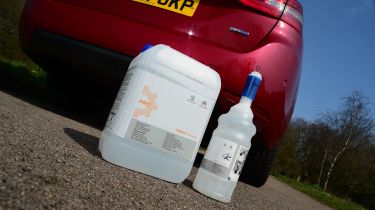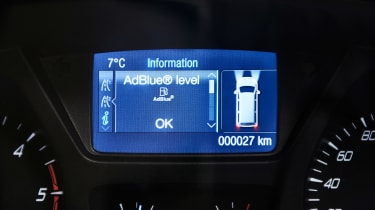What is AdBlue?
Euro 6 emissions regulations and SCR tech mean AdBlue usage is increasing rapidly – but what is AdBlue?

You’ve probably seen containers of AdBlue, or diesel exhaust fluid to use its generic name, stacked up for sale at your local petrol station, but unless you’ve owned a diesel car or van fitted with SCR – or Selective Catalytic Reduction – you’ve probably not had cause to buy or use it.
So if you’re not sure what AdBlue is for, which vehicles use it and where and how often you need to top it up, don’t worry as you’re not alone. Our guide to AdBlue tells you everything you’ll need to know.
What is AdBlue made of and how does it work?
AdBlue is a liquid solution of 32.5 per cent urea (the stuff found in urine) and 67.5 per cent deionised water. Designed as an exhaust treatment to reduce harmful emissions, when AdBlue meets hot exhaust gases it releases ammonia, creating a catalytic reaction that converts dangerous Nitrogen Oxide into water vapour and nitrogen, both of which are totally harmless. Both products occur naturally, and so can be pumped out of an AdBlue-equipped car without any ill effects.
You might be familiar with urea in that it’s found in urine, but diesel exhaust fluid isn’t actually derived from human or animal waste products, much as the idea might amuse your kids. The stuff used in your car is a man-made substance created by exposing synthetic ammonia and carbon dioxide to heat. As well as being used in liquid form, AdBlue suppliers also make dry pellets for farmers to scatter on their fields as a form of fertiliser.
Can I refill AdBlue myself?
Yes, you can refill AdBlue yourself, and it’s a really simple process. Your AdBlue tank should be topped up at every service and your dealer will happily refill it at other times if required, but this is far from the cheapest option.
With tanks varying in size from 5 to 20 litres, and a mid-size family diesel consuming a litre of AdBlue every 600-odd miles, the requirement to top up the AdBlue may be quite frequent for high mileage diesel drivers.

Fortunately, your car will monitor consumption and either post messages on your car’s digital display or flash up dashboard warning lights as the level drops. It’s wise not to ignore them, as once the AdBlue is all gone the car may not start until the tank is topped up again. (This is to ensure cars don't drive illegally with high exhaust emissions.)
You shouldn’t have any trouble topping up your AdBlue tank. Nowadays the AdBlue filler cap is often located next to the diesel filler, and the fluid is typically sold in handy containers that dispense without drips – important, as although the AdBlue is pretty harmless to people, it can be quite corrosive to vehicle paintwork or other less obvious things like your car’s wiring. It can also smell pretty bad if you spill a container of it – as we know from experience.
Older cars may have their AdBlue filler caps inside the vehicle or under the bonnet, but your handbook will tell you where to find it (some cars have digital handbooks in the infotainment system, so you may need to check there).
While AdBlue liquid may look like water and has a blue filler cap, do not mistake this for a water tank. Filling the AdBlue tank with water could run the risk of causing significant damage to the SCR system which is costly to repair. If you’re buying a diesel car for the first time and don’t know where the AdBlue tank is located, be sure to ask the dealer or previous owner when the vehicle is handed over – it will also be noted in your vehicle's handbook.
I have an AdBlue warning light – what does this mean?
All diesel cars that use AdBlue will give you plenty of warning if you’re starting to run low. Your car will monitor consumption and give you a series of dashboard warning signs or lights as the level drops – typically from around 1,500 miles. The warning light will remain on every time you restart the car until you refill the AdBlue tank.
Manufacturers haven’t yet settled on a standardised graphic for their AdBlue warnings in cars. Graphics range from generic AdBlue text with a spanner symbol, through a petrol pump symbol with AdBlue written on it, to a pouring bottle, or the slightly more obscure graphic of exhaust smoke with droplets falling through it. As most modern cars have digital information displays though, most cars will make it pretty clear when the tank needs topping up, just as they do for regular refuelling or oil top-ups.
I’ve run out of AdBlue, can I still drive my car?
Ignoring the AdBlue warning light on your dashboard is not advised under any circumstances. If you run out of AdBlue while driving, you will still be able to carry on, but your car will go into ‘limp mode’, where the engine limits performance to reduce its emissions output. ‘Limp mode’ will also reduce the speed at which you can drive and may even turn off features such as the air conditioning or radio to preserve power.
Once you’ve stopped and turned off the engine, the majority of modern diesel cars cannot be restarted if the AdBlue is completely empty. Thankfully, your car will start and run as normal once the AdBlue tank has been refilled.
Where can I buy AdBlue?
AdBlue is widely available from car dealers and independent garages, as well as accessory shops and chains online. It’s also a staple of every filling station these days, but it’s worth shopping around as costs can vary widely, from around £1 a litre to nearly £4 per litre. You can in theory save a little money by buying higher volumes, though as AdBlue top-ups aren’t especially frequent unless you do huge miles, it probably isn’t worth buying in bulk just to save a few quid.
When buying AdBlue, you should check it meets the right specifications – look for the ISO 22241 number on the container. AdBlue also has an expiration date and shouldn’t be used beyond this point as it may damage the SCR system, so be sure to double check before purchasing.
Selective Catalytic Reduction (SCR)
When diesel engines burn fuel, it’s well-known that a wide range of polluting compounds and chemicals are pumped out of the exhaust pipe and into the atmosphere. Nitrogen Oxide and Nitrogen Dioxide are two of the most unpleasant tailpipe pollutants, as they’re the ones that are said to contribute to breathing and respiratory problems in vulnerable people. They also build up in the atmosphere to cause smog and acid rain, so it’s no surprise that lawmakers around the world want to see them eradicated.
One way the automotive industry has adapted to deal with the problem is through Selective Catalytic Reduction or SCR, which is a process designed to remove these oxides from exhaust gas. And while SCR is highly effective, it does require small amounts of a liquid solution to be injected into the exhaust – and that’s where AdBlue comes in.
Which vehicles use AdBlue and SCR?
AdBlue and SCR technology first started to appear in commercial and heavy goods vehicles as far back as 2004, and some manufacturers like Mercedes and Volkswagen have been using it for nearly as long.
It’s the latest Euro 6 emissions regulations from the European Commission that have really driven an explosion in SCR technology from the passenger car perspective in Europe, though. The Euro 6 regs introduced in 2014/15 demanded nitrogen oxide emissions be cut by a whopping 56 per cent compared to Euro 5 levels. For most diesel engines over 1.6-litres in capacity, AdBlue and SCR technology has been the only means to achieve this – so most diesels over that size will feature an AdBlue tank and these days there are fewer and fewer smaller diesel cars on the market.
Did you know you can sell your car with Auto Express? Get the highest bid from our network of over 5,500 dealers and we'll do the rest. Click here to try Auto Express Sell My Car now...
Find a car with the experts






